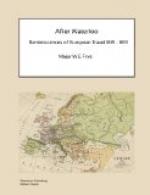called l’Amfiteatro Farnese in honour
of the former sovereigns of the Duchy. It is a
vast building and unites the conveniences both of
the ancient and modern theatres. It has a roof
like a modern theatre, and the seats in the parterre
are arranged like the seats in an ancient Greek theatre.
Above this are what we should call boxes, and above
them again what we usually term a gallery. A
vast and deep arena lies between the parterre
and the orchestra and fills up the space between the
audience and the proscenium. It is admirably
adapted both for spectators and hearers; when a tragedy,
comedy or opera is acted, a scaffolding is erected
and seats placed in the arena. At other times
the arena is made use of for equestrian exercises and
chariot races in the style of the ancients, combats
with wild beasts, etc., or it may be filled with
water for the representation of naval fights (naumachia);
in this case you have a vast oval lake between the
spectators and the stage. It is a great pity that
this superb and interesting building is not kept in
good repair; the fact is it is seldom or ever made
use of except on very particular occasions: it
is almost useless in a place like Parma, “so
fallen from its high estate,” but were such
an amphitheatre in Paris, London, or any great city,
it might be used for all kinds of spectacles
and amusements. A small theatre from the design
of Bernino stands close to this amphitheatre, and is
built in a light tasteful manner. If fresh painted
and lighted up it would make a very brilliant appearance.
This may be considered as the Court theatre. At
a short distance from the theatres is the Museum of
Parma, in which there is a well chosen gallery of
pictures. Among the most striking pictures of
the old school is without doubt that of St Jerome
by Correggio; but I was full as much, dare I be so
heretical as to say more pleased, with the productions
of the modern school of Parma. A distribution
of prizes had lately been made by the Empress Maria
Louisa, and there were many paintings, models of sculpture
and architectural designs, that did infinite credit
to the young artists. I remarked one painting
in particular which is worthy of a Fuseli. It
represented the battle of the river God Scamander
with Achilles. The subjects of most of the paintings
I saw here were taken from the mythology or from ancient
and modern history; and this is perhaps the reason
that they pleased me more than those of the ancient
masters. Why in the name of the [Greek:
to kalon] did these painters confine themselves so
much to Madonnas, Crucifixions, and Martyrdoms, when
their own poets, Ariosto and Tasso, present so many
subjects infinitely more pleasing? Then, again,
in many of these crucifixions and martyrdoms, the
gross anachronisms, such as introducing monks and soldiers
with match-locks and women in Gothic costume at the
crucifixion, totally destroy the seriousness and interest
of the subject by annihilating all illusion and exciting
risibility.




